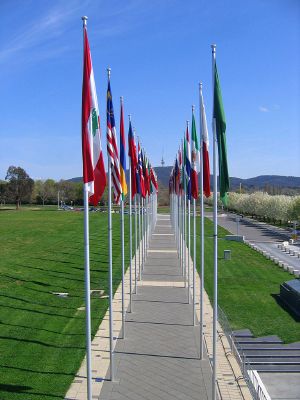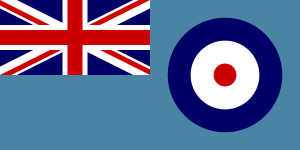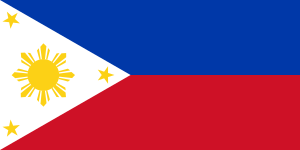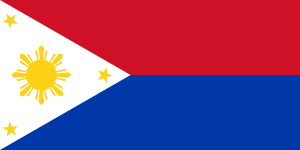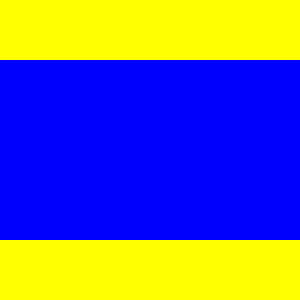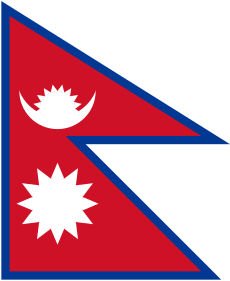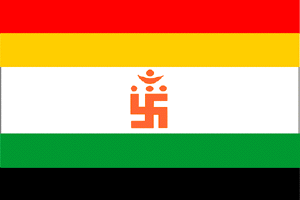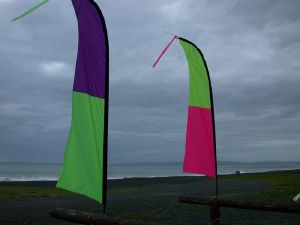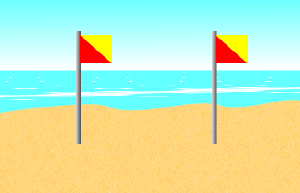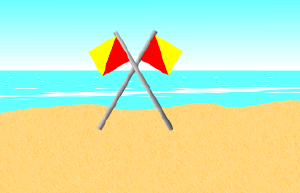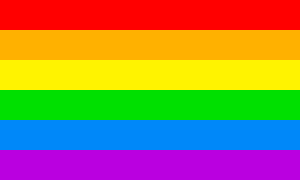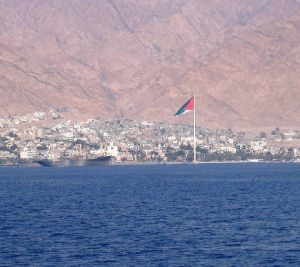Difference between revisions of "Flag" - New World Encyclopedia
| Line 105: | Line 105: | ||
In [[Australia]], [[New Zealand]], [[Philippines]], and the [[United Kingdom]] a pair of red/yellow flags is used to mark the limits of the bathing area on a beach, usually guarded by [[surf lifesaving|surf lifesavers]]. If the beach is closed, the poles of the flags are crossed. The flags are colored with a red triangle and a yellow triangle making a rectangular flag, or a red rectangle over a yellow rectangle. On many Australian beaches there is a slight variation with beach condition signalling. A red flag signifies a closed beach (or, in the UK, some other danger), yellow signifies strong current or difficult swimming conditions, and green represents a beach safe for general swimming. In [[Ireland]], a red and yellow flag indicates that it is safe to swim; a red flag that it is unsafe; and no flag indicates that there are no lifeguards on duty. Blue flags may also be used away from the yellow-red lifesaver area to designate a zone for surfboarding and other small, non-motorised watercraft. | In [[Australia]], [[New Zealand]], [[Philippines]], and the [[United Kingdom]] a pair of red/yellow flags is used to mark the limits of the bathing area on a beach, usually guarded by [[surf lifesaving|surf lifesavers]]. If the beach is closed, the poles of the flags are crossed. The flags are colored with a red triangle and a yellow triangle making a rectangular flag, or a red rectangle over a yellow rectangle. On many Australian beaches there is a slight variation with beach condition signalling. A red flag signifies a closed beach (or, in the UK, some other danger), yellow signifies strong current or difficult swimming conditions, and green represents a beach safe for general swimming. In [[Ireland]], a red and yellow flag indicates that it is safe to swim; a red flag that it is unsafe; and no flag indicates that there are no lifeguards on duty. Blue flags may also be used away from the yellow-red lifesaver area to designate a zone for surfboarding and other small, non-motorised watercraft. | ||
| + | |||
| + | * For safety, [[Glossary of SCUBA diving|dive flags]] indicate the locations of underwater [[SCUBA diving|scuba divers]]. | ||
| + | * In water sports such as Wakeboarding and Water-Skiing, an orange flag is held in between runs to indicate someone is in the water. | ||
== Railway flags == | == Railway flags == | ||
Revision as of 18:33, 27 April 2008
- For other uses, see Flag (disambiguation).
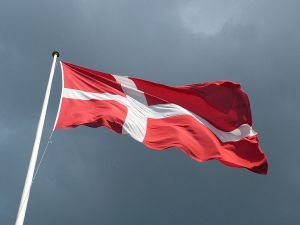
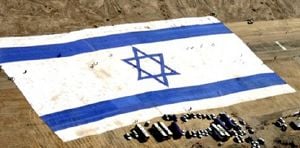
A flag is a piece of cloth, often flown from a pole or mast, that is generally used symbolically by a nation, state or organization. National flags can be important patriotic symbols with varying interpretations, from country to country.
The study of flags is known as vexillology, from the Latin vexillum meaning flag or banner. Flags are extremely multi-purpose and can also be used for messaging, advertising, signalling, or for simply decorative purposes.
The history of the flag dates back to at least Roman times. In recent years, the United States flag has drawn controversy and debate over the wording of the pledge of allegiance and the constitutionality of flag burning as a means of civil disobedience.
History
The first flags were used to assist military coordination on battlefields and flags have evolved into a general tool for rudimentary signalling and identification, This was especially used in environments where communication is similarly challenging (such as the maritime environment where semaphore is used). Although flag-like symbols were used in some ancient cultures, the origin of flags in the modern sense is a matter of dispute. Some believe flags originated in China, while others hold that the Roman Empire's vexillum or the cyrus the great's standard (a hawk) were the first true flag and flags are also prominently been mentioned in the Indian epic of Mahabharata. Originally, the standards of the Roman legions were not flags, but symbols like the eagle of Augustus Caesar's Xth legion; this eagle would be placed on a staff for the standard-bearer to hold up during battle. But a military unit from Scythia had for a standard a dragon with a flexible tail which would move in the wind; the legions copied this; eventually all the legions had flexible standards—our modern-day flag.
During the Middle Ages, flags were used mainly during battles to identify individual leaders: in Europe the knights, in Japan the samurai, and in China the generals under the imperial army.
From the time of Christopher Columbus onwards, it has been customary (and later a legal requirement) for ships to carry flags designating their nationality;[2] these flags eventually evolved into the national flags and maritime flags of today. Flags also became the preferred means of communications at sea, resulting in various systems of flag signals; see International maritime signal flags.
As European knights were replaced by centralized armies, flags became the means to identify not just nationalities but also individual military units. Flags became objects to be captured or defended. Eventually these flags posed too much danger to those carrying them, and by World War I these were withdrawn from the battlefields, and have since been used only at ceremonial occasions.
National flags
One of the most popular uses of a flag is to symbolize a nation or country. Some national flags have been particularly inspirational to other nations, countries, or subnational entities in the design of their own flags. Some prominent examples include:
- The flag of Denmark is the oldest state flag still in use. This flag, called the Dannebrog, inspired the cross design of the other Nordic countries: Norway, Sweden, Finland, Iceland, and regional flags for the Faroe Islands, Åland, and Scania.
- The Union Flag (Union Jack) of the United Kingdom. British colonies typically flew a flag based on one of the ensigns based on this flag, and many former colonies have retained the design to acknowledge their cultural history. Examples: Australia, Fiji, New Zealand, Tuvalu, and also the Canadian provinces of Manitoba and Ontario, and the American state of Hawaii; see commons:Flags based on British ensigns.
- The Tricolor of The Netherlands is the oldest tricolour, first appearing in 1572 as the Prince's Flag in orange–white–blue. Soon the more famous red–white–blue began appearing—it is however unknown why, though many stories are known. After 1630 the red–white–blue was the most commonly seen flag. The Dutch Tricolor has inspired[citation needed] many flags but most notably those of Russia, India and France, which spread the tricolor concept even further. The Flag of the Netherlands is also the only flag in the world that is adapted for some uses, when the occasion has a connection to the royal house of the Netherlands an orange ribbon is added.
- The national flag of France, also called the Tricolore, which inspired[citation needed] other nations to adopt differenced tricolours in sympathy with the revolutionary spirit with which the flag was designed in 1794. Examples among many: Costa Rica, Ireland, Italy, Romania, Mexico.
- The flag of the United States, also nicknamed The Stars and Stripes or Old Glory. In the same way that nations looked to France for inspiration, many countries were also inspired by the American Revolution, which they felt was symbolized in this flag. Examples: Cuba, Liberia, Chile, Uruguay, and the French region of Brittany.
- The flag of Russia, the source for the Pan-Slavic colors adopted by many Slavic states and peoples as their symbols. Examples: Slovakia, Serbia, Croatia, Slovenia.
- Ethiopia was seen as a model by emerging African states of the 1950s and 1960s, as it was one of the oldest independent states in Africa. Accordingly, its flag became the source of the Pan-African colours. Examples: Togo, Senegal, Ghana, Mali.
- The flag of Turkey, which was the flag of the Ottoman Empire, has been an inspiration for the flag designs of many other Muslim nations. During the time of the Ottomans the crescent began to be associated with Islam and this is reflected on the flags of Algeria, Azerbaijan, Comoros, Malaysia, Mauritania, Pakistan, Tunisia, and of the Turkish Republic of Northern Cyprus.
- The Pan-Arab colors, green, white, red and black, are derived from the flag of the Great Arab Revolt as seen on the flags of Jordan, Kuwait, Sudan, Syria, the United Arab Emirates, Western Sahara, Egypt, Iraq, Yemen and Palestine.
- The Soviet flag, with its golden symbols of the hammer and sickle on a red field, was an inspiration to flags of other communist states, such as East Germany, People's Republic of China, Vietnam, Angola, Afghanistan and Mozambique.
- The flag of Venezuela, created by Francisco de Miranda to represent the independence movement in Venezuela that later gave birth to the "Gran Colombia", inspired the individual flags of Colombia, Ecuador and Bolivia, all sharing three bands of color and three of them (Colombia, Ecuador, and Venezuela) sharing the yellow, blue and red.
- The flag of Argentina, created by Manuel Belgrano during the war of independence, was the inspiration for the United Provinces of Central America's flag, which in turn was the origin for the flags of Guatemala, Honduras, El Salvador, and Nicaragua.
Flag Day
Flag days are usually codified in national statutes, however, a decree by a head of state of the specific country can also order flag days. The display of the national flag on this day, mainly to fix it at either full or half staff. The locations of where the flags are flown (and how are they flown) can be also dictated by national law or decree.
War flags
Some national flags have strong military associations due to their original and ongoing military uses. Several countries (including the United Kingdom and the former Nazi Germany) have their armed forces fly uniquely designed flags rather than the national flag.
Other countries' armed forces (such as those of the United States or Switzerland) use their standard national flag. The Philippines' armed forces may use their standard national flag, but during times of war the flag is turned upside down.
Large versions of the war flag flown on the warships of countries' navies are known as battle ensigns. During times of war, the waving of a white flag indicates surrender.
The flag of the Philippines is flown differently depending on whether the country is at peace (blue on top) or war (red on top).
Flags at sea
Flags are particularly important at sea, where they can mean the difference between life and death, and consequently where the rules and regulations for the flying of flags are strictly enforced. A national flag flown at sea is known as an ensign. A courteous, peaceable merchant ship or yacht customarily flies its ensign (in the usual ensign position), together with the flag of whatever nation it is currently visiting at the mast (known as a courtesy flag). To fly one's ensign alone in foreign waters, a foreign port or in the face of a foreign warship traditionally indicates a willingness to fight, with cannon, for the right to do so. As of 2006, this custom is still taken seriously by many naval and port authorities and is readily enforced in many parts of the world by boarding, confiscation and other civil penalties.
In some countries yacht ensigns are different from merchant ensigns in order to signal that the yacht is not carrying cargo that requires a customs declaration. Carrying commercial cargo on a boat with a yacht ensign is deemed to be smuggling in many jurisdictions.
There is a system of international maritime signal flags for numerals and letters of the alphabet. Each flag or pennant has a specific meaning when flown individually.
As well, semaphore flags can be used to communicate on an ad hoc basis from ship to ship over short distances.
Shape and design
Flags are usually rectangular in shape (often in the ratio 2:3 or 3:5), but may be of any shape or size that is practical for flying, including square, triangular, or swallow tailed. A more unusual flag shape is that of the flag of Nepal, which is in the shape of two stacked triangles.
Many flag merchants prey on unwary buyers by offering incorrect flags, such as with the wrong proportions, crudely drawn, or one-sided. Some reference materials alter the flag proportions so they look uniform, such as decades of editions of the annual World Almanac and Book of Facts.
Common designs on flags include crosses, stripes, and divisions of the surface, or field, into bands or quarters — patterns and principles mainly derived from heraldry. A heraldic coat of arms may also be flown as a banner of arms, as is done on both the state flag of Maryland and the flag of Kiribati.
The flag of Libya, which consists of a rectangular field of green, is the only national flag using a single color and no design or insignia.
Religious flags
Flags can play many different roles in religion. In Buddhism, prayer flags are used, usually in sets of five differently colored flags. Many national flags and other flags include religious symbols such as the cross, the crescent, or a reference to a patron saint. Flags are also adopted by religious groups and flags such as the Jain flag and the Christian flag are used to represent a whole religion.
In sports
Because of their ease of signalling and identification, flags are often used in sports.
- In American and Canadian football, referees use flags to indicate an error has been made in game play. The phrase used for such an indication is flag on the play. The flag itself is a small, weighted handkerchief, tossed on the field at the approximate point of the infraction; the intent is usually to sort out the details after the current play from scrimmage has concluded. In American football, the flag is usually yellow; in Canadian football, it is usually red.
- In yacht racing, flags are used to communicate information from the race committee boat to the racers. Different flags hoisted from the committee boat may communicate a false start, changes in the course, a canceled race, or other important information. Racing boats themselves may also use flags to symbolize a protest or distress. The flags are often part of the nautical alphabetic system of International maritime signal flags, in which 26 different flags designate the 26 letters of the Latin alphabet.
- In auto and motorcycle racing, racing flags are used to communicate with drivers. Most famously, a checkered flag of black and white indicates the end of the race, and victory for the leader. A yellow flag is used to indicate caution requiring slow speed and a red flag requires racers to stop immediately. A black flag is used to indicate penalties.
- In Association football (soccer), linesmen carry small flags along the touch lines. They use the flags to indicate to the referee potential infringements of the laws, or who is entitled to possession of the ball that has gone out of the field of play, or, most famously, raise the flag overhead to indicate an offside offence. Officials called touch judges use flags for similar purposes in both codes of rugby.
- In addition, fans of almost all sports wave flags in the stands to indicate their support for the participants. Many sports teams have their own flags, and, in individual sports, fans will indicate their support for a player by waving the flag of his or her home country.
Swimming flags
In Australia, New Zealand, Philippines, and the United Kingdom a pair of red/yellow flags is used to mark the limits of the bathing area on a beach, usually guarded by surf lifesavers. If the beach is closed, the poles of the flags are crossed. The flags are colored with a red triangle and a yellow triangle making a rectangular flag, or a red rectangle over a yellow rectangle. On many Australian beaches there is a slight variation with beach condition signalling. A red flag signifies a closed beach (or, in the UK, some other danger), yellow signifies strong current or difficult swimming conditions, and green represents a beach safe for general swimming. In Ireland, a red and yellow flag indicates that it is safe to swim; a red flag that it is unsafe; and no flag indicates that there are no lifeguards on duty. Blue flags may also be used away from the yellow-red lifesaver area to designate a zone for surfboarding and other small, non-motorised watercraft.
- For safety, dive flags indicate the locations of underwater scuba divers.
- In water sports such as Wakeboarding and Water-Skiing, an orange flag is held in between runs to indicate someone is in the water.
Railway flags
Railways use a number of colored flags. When used as wayside signals they usually have the following meanings (exact meanings are set by the individual railroad company): red = stop, yellow = proceed with care, green or white or blue = proceed, and a flag of any color waved vigorously means stop.
A blue flag on the side of a locomotive means that it should not be moved because someone is working on it (or on the train attached to it). A blue flag on a track means that nothing on that track should be moved. The flag can only be removed by the person or group that placed it.
At night, the flags are replaced with lanterns showing the same colors.
Flags displayed on the front of a moving locomotive are an acceptable replacement for classification lights and usually have the following meanings (exact meanings are set by the individual railroad company): white = extra (not on the timetable),green = another section following, red = last section.
Additionally, a railroad brakeman will typically carry a red flag to make his or her hand signals more visible to the engineer. Railway signals are a development of railway flags.[3]
In politics
Social and political movements have adopted flags, to increase their visibility and as a unifying symbol.
The socialist movement uses red flags to represent their cause. The anarchism movement has a variety of different flags, but the primary flag associated with them is the black flag. In the 1970s, the rainbow flag was adopted as a symbol of the LGBT social movements. Bisexual and transgender pride flags were later designed, in an attempt to emulate the rainbow flag's success. Some of these political flags have become national flags; such as the red flag of the Soviet Union and national socialist banners for Nazi Germany.
Flagpoles
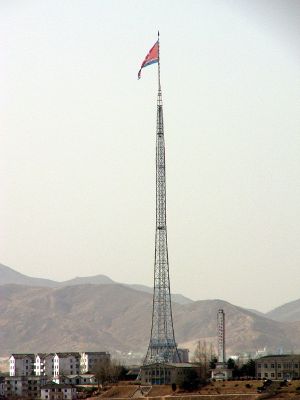
A flagpole or flagstaff can be a simple support made of wood or metal. If it is taller than can be easily reached to raise the flag, a cord is used, looping around a pulley at the top of the pole with the ends tied at the bottom. The flag is fixed to one lower end of the cord, and is then raised by pulling on the other end. The cord is then tightened and tied to the pole at the bottom. The pole is usually topped by a flat plate called a "truck" (originally meant to keep a wooden pole from splitting) or by a ball or a finial in a more complex shape.
Very high flagpoles may require more complex support structures than a simple pole, such as guy wires, or need be built as a mast. The highest flagpole in the world, at 160 metres (525 feet), is that at Gijeong-dong in North Korea, the flag weighing about 270 kilograms (600 pounds) when dry.[4] The world's biggest regularly hoisted flag, however, is the Brazilian national flag flown in the Square of the Three Powers in Brasilia, the capital of Brazil. This flag weighs about 600 kilograms (1300 pounds) when dry and measures 70×100 metres (230x330 feet). It can be seen from all parts of Brasilia and its flagpole is the tallest structure in the city.
The tallest free-standing flagpole in the world is the Aqaba Flagpole in Aqaba, Jordan, with a total height of 132 meters (430 feet). The Raghadan Flagpole, also in Jordan, is the second tallest free-standing flagpole in the world. It reaches a height of 126 meters (410 feet) and hoists a flag that measures 60 by 40 meters (200 by 130 feet); it is illuminated at night and can be seen from 25 km (16 miles) away.
Design
Flagpoles can be designed in one piece with a taper (typically a cone taper or a Venetian/Greek entasis taper),[5] or be made from multiple pieces to make them able to expand. In the United States, ANSI/NAAMM guide specification FP-1001-97 covers the engineering design of metal flagpoles to ensure safety.
ReferencesISBN links support NWE through referral fees
- Crampton, W. G. 1994. The world of flags. IL: Rand McNally. ISBN 0528837206
- DK Publishing, Inc. 1997. Ultimate pocket flags of the world. New York, N.Y.: DK Pub. ISBN 0789420856
Notes
- ↑ Since November 25th, 2007, according to Guiness World Records.
- ↑ Articles 90-94 of the UN Convention on the Law of the Sea
- ↑ Early Railway Signals - Retrieved December 19, 2007.
- ↑ Korea's DMZ: Scariest place on Earth - Retrieved December 19, 2007.
- ↑ Cone Tapered vs. Venetian Entasis Tapered - Retrieved December 19, 2007.
External links
All links retrieved December 19, 2007.
- fotw.net, Flags of the World, an outstanding source of vexillological information, contributed to by a group of international volunteers.
- World Flag Database
- Flag news and views
| |||||||||||||||||||||||
Credits
New World Encyclopedia writers and editors rewrote and completed the Wikipedia article in accordance with New World Encyclopedia standards. This article abides by terms of the Creative Commons CC-by-sa 3.0 License (CC-by-sa), which may be used and disseminated with proper attribution. Credit is due under the terms of this license that can reference both the New World Encyclopedia contributors and the selfless volunteer contributors of the Wikimedia Foundation. To cite this article click here for a list of acceptable citing formats.The history of earlier contributions by wikipedians is accessible to researchers here:
The history of this article since it was imported to New World Encyclopedia:
Note: Some restrictions may apply to use of individual images which are separately licensed.
